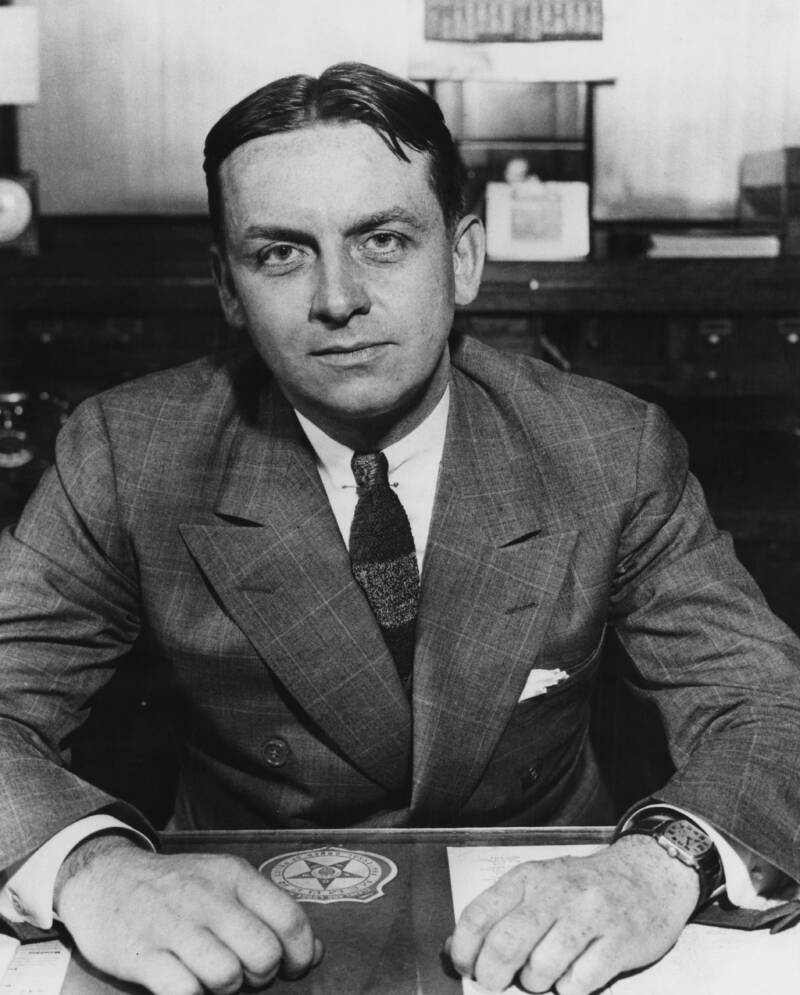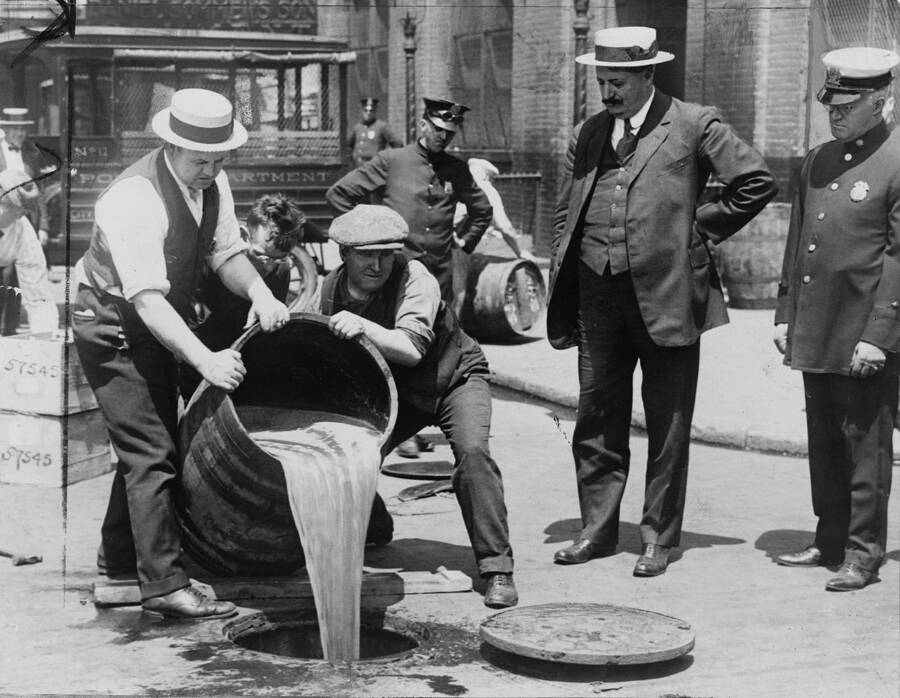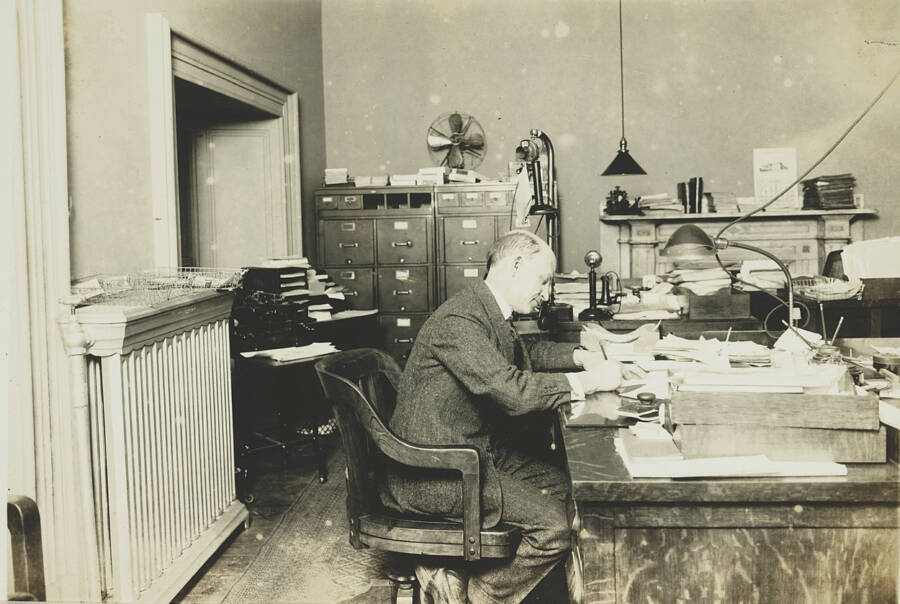Working in Chicago during Prohibition, Eliot Ness served in a special police division nicknamed the "Untouchables" that put Al Capone in prison for tax evasion.
Among the many larger-than-life figures who emerged during the Prohibition era, one lawman towered above the rest. Eliot Ness, a former insurance claim investigator from Chicago’s South Side, might have been the least likely candidate to become an icon of the fight against alcohol — especially since he was known to enjoy a glass of booze.
But during his time with the Prohibition Bureau, Ness earned a reputation for honesty and efficiency, traits that were hard to find in Chicago, a city where “the skies were black with smoke from ‘alky’ cooking plants, beer was as easy to get as water, and it was a foolhardy policeman who dared molest a citizen peddling whiskey that would eat a hole in a battleship.”
Defying the odds, Ness and his team of special agents, The Untouchables, helped to topple the infamous gangster Al Capone and to dismantle an empire of vice that had infected every corner of life in the Windy City.
Eliot Ness’s Early Years In The Prohibition Bureau

Hulton Archive/Getty ImagesThough he relied on family connections to join the Prohibition Bureau, Eliot Ness proved to be an effective lawman.
Born in Chicago on April 19, 1903, Eliot Ness was raised by his Norwegian immigrant parents on the South Side of the city. After finishing school, he initially pursued a somewhat dull job investigating insurance claims.
By the time Ness joined the Treasury Department in the late 1920s — thanks to connections and encouragement from his brother-in-law — the Prohibition Bureau was widely viewed as a failure in Chicago.
Once the manufacture, transportation, and sale of alcohol had been outlawed by the Volstead Act, many breweries and distilleries in the city gladly allowed underworld figures — like the Chicago Outfit’s Johnny Torrio and his violent lieutenant Al Capone — to take over their operations. And countless public officials were paid handsomely to look the other way.
From simple beat cops to elected politicians, public figures in Chicago accepted up to $30 million in bribes per year. This made the Second City one of the most corrupt places in the country during the Prohibition era.
Ness became a Prohibition agent despite the protests of some of his relatives. Prohibition agents, commonly called “Prohis,” were not widely respected, even among the most dedicated temperance activists. “Almost without exception, the [Prohibition] agents are not men of the type of intelligence and character qualified to be charged with this difficult and important duty and Federal law,” a federal grand jury stated in 1921.
Eliot Ness was a contradictory man, known for being scrupulously honest and for refusing any bribes that he was offered, but also known for personally enjoying a drink or two himself. His own fondness for spirits notwithstanding, Ness was committed to stamping out the illicit liquor industry, and he was about to do so in the most theatrical way possible.
How Eliot Ness Joined The “Capone Squad”

Library of CongressProhibition agents raiding liquor warehouses frequently posed for publicity shots like this one.
In a time of widespread corruption in America, many honest government employees were left frustrated. As Justice Department official Mabel Walker Willebrandt once said in exasperation, she found it hard to believe that “out of our one hundred and twenty million population… it is impossible to find four thousand men in the United States who cannot be bought.”
Meanwhile, U.S. Attorney George E.Q. Johnson was determined to find a few of those men to help bring down Capone in Chicago. He planned a two-pronged attack: While a team of tax experts pried open Capone’s books, a “Capone squad” of law enforcement officers would disrupt the gangster’s operations and seek out further evidence of his violations of Prohibition laws. Eliot Ness was almost immediately tapped to head the unit in 1930.
Although legend has it that Ness personally selected the most upright agents he could find, choosing only the most honest and competent men on the Bureau’s payroll, the truth is that his Capone squad was initially staffed with whoever he could find. Some men only lasted a few days with the unit, while a handful would stay by Ness’s side until the very end.
These men included Joe Leeson, who was known as the country’s best “tail-car man”; Paul Robsky, a Prohibition agent from South Carolina who claimed to have run 30 bootleggers’ cars off the road in one month; and Samuel “Maurice” Seager, a former Sing Sing Prison death row guard.
Their part in Johnson’s campaign was to stage lightning-fast raids on the Chicago Outfit’s distilleries and breweries, disrupting the torrent of cash that poured up the ladder to Capone’s pockets. This bold operation would also give the stolid accountants time to peruse the books.
When “The Untouchables” Were Born

Federal Bureau of Investigation/Wikimedia Commons Al Capone was at one time among the most powerful men in the country, controlling vast swaths of Chicago’s underworld and raking in millions in annual liquor sales.
In the first six months alone, Eliot Ness and his men had shut down 19 distilleries and six major breweries, causing Capone to lose $1 million. Though the Chicago Outfit still had plenty of other streams of income, Ness’s persistence made him increasingly problematic to Capone.
At first, the gangster tried a soft approach, having his crew tempt Ness’s agents with envelopes full of cash. One of Capone’s men even paid a visit to Ness himself. On that day in 1930, Capone’s henchman strolled right into Ness’s office and offered to pay him $2,000 per week if he would “take it easy.” Ness adamantly refused the offer and ordered the man out.
When the bribes didn’t work, Ness became a target of threats and even some attacks. Ness’s car was stolen multiple times, his offices were raided, his phone was tapped, and he even caught one of Capone’s men spying on his parents’ home. But Ness still refused to back down.
In his signature dramatic fashion, Ness called the press to his office and announced that he could never be bought by Capone — and neither could any of the other agents who were part of his loyal crew.
It was this resistance to both coercion and intimidation that led Charles Schwarz from the Chicago Daily News to nickname the unit “The Untouchables.” Interestingly enough, this name was likely inspired by Mahatma Gandhi’s efforts to publicize the plight of the downtrodden in India.
Ness liked the title, but it was his boss, Johnson, who made sure that the name, with its implications of implacable lawmen following the letter and the spirit of the law, would appear in newspapers across the country.
Who Really Brought Down Scarface?

Library of CongressFar less dashing but far more important than The Untouchables was a team of dedicated financial experts who worked tirelessly to find evidence that Capone had failed to pay his taxes for years.
The Untouchables didn’t just make a dent in Capone’s operations with raids. By mid-1931, the agents had also racked up evidence of over 5,000 Volstead Act violations linked to Capone and his criminal organization. In the end, their efforts would cost the Chicago Outfit about $9 million in revenue.
As Eliot Ness noted, “the Capone organization felt the presence of this small United States Attorney’s group more acutely than any other organization.”
The raids and wiretaps captivated the imaginations of both the public and Capone himself, who began to focus more on his media portrayal than on combatting The Untouchables. As the gangster tried to clean up his public image, Ness zeroed in on crippling his finances even more. Meanwhile, a less glamorous assault was being staged against the Chicago Outfit.
Ultimately, Capone was brought down by his tax evasion case, not by his violations of the Volstead Act. There’s little doubt that Ness and The Untouchables helped tie up Capone’s resources and deprive him of his sorely-needed capital. But they didn’t have much to do with the tax evasion trial, and thus, they were not responsible for his final downfall.
That honor largely belonged to a special agent named Frank J. Wilson, who worked for the Intelligence Unit of the IRS. Leading a team of unassuming accountants, Wilson was known as the type of man who would “sit quietly looking at books eighteen hours a day, seven days a week, forever, if he wants to find something in those books.”
It was Wilson who discovered a connection to Capone in a ledger detailing gambling revenues. After locating Capone’s bookkeeper, Wilson was eventually able to establish Capone’s income. This would help accumulate evidence that Capone had failed to pay $215,000 in income taxes.
Wilson’s efforts directly contributed to Capone being sentenced to 11 years in prison for tax evasion in 1931. In the end, a methodical bean counter had helped put away the country’s most notorious gangster.
What Happened To Eliot Ness After Prohibition?

Paramount PicturesEliot Ness’s 1957 book The Untouchables launched a renewed fascination with the crime-fighting unit and their role in the effort to put Al Capone away. The book also inspired a 1960s TV series and an iconic 1987 film by the same name.
The Untouchables disbanded soon after Capone’s highly-publicized trial. Since the infamous gangster was already behind bars and Prohibition would soon be repealed in 1933, there was no longer a need for them to focus on the same assignments they did in the years prior. Many of the core members of the team simply moved on to other positions in law enforcement.
As for Eliot Ness, he attempted to join the FBI. While he might’ve seemed like a shoo-in for the job, his efforts were ultimately nixed by the powerful director J. Edgar Hoover — who by then was one of Ness’s biggest rivals.
Not to be deterred, Ness moved to Cleveland in 1934 to lead the Regional Office. Just a year later, he would become the city’s Safety Director.
Not only did he weed out 200 crooked cops from the police force, but he also faced off against Mafia bosses, one of whom threatened to knock the head off of any cop who came inside his gambling house. Ever unafraid, Ness simply said, “Let’s have a fight here,” and let his raid on the house begin.
For the most part, Ness was respected for his efforts to bring down crime in Cleveland and to fix the city’s traffic problems. However, his fame slowly began to fade as Prohibition became a distant memory. And in time, his impeccable reputation as a lawman soon began to fade as well.
In 1942, he was caught covering up his own hit-and-run accident. Even worse, he had been accused of driving drunk just before the crash happened. While there were no victims, the incident still hurt his image. It didn’t help that he and his first wife had divorced a few years prior — which was considered controversial in the largely Catholic city of Cleveland.
Eliot Ness soon left law enforcement, opting for various positions in the federal government and the private sector before launching a number of unsuccessful businesses. Before long, he was spending most of his time at bars, occasionally recounting his glory days with The Untouchables.
Though Ness was broke and largely forgotten by this point, he would soon resurface in the public imagination once again. In the mid-1950s, Ness had a fateful meeting with Oscar Fraley, a sportswriter who took a genuine interest in the former lawman’s story — especially his role in taking on Capone.
Fraley pushed Ness to send him an account of his time with his famous crime-fighting unit, which would form the basis for the bestselling 1957 book The Untouchables. That book would later inspire a 1960s TV series by the same name as well as an iconic 1987 film starring Kevin Costner as Ness.
But tragically, Eliot Ness did not live to see his second chance at fame. He died of a heart attack at age 54 in 1957 (Al Capone himself died 10 years earlier at age 48 due to syphilis) — shortly before the book was published. Still, his legacy as an “untouchable” lawman who helped pioneer the modern police force lives on. And to this day, he’s remembered as one of the most legendary special agents in American history.
After learning about Eliot Ness, discover the life of Al Capone in these captivating images. Then, meet some other gangsters from the 1920s.





